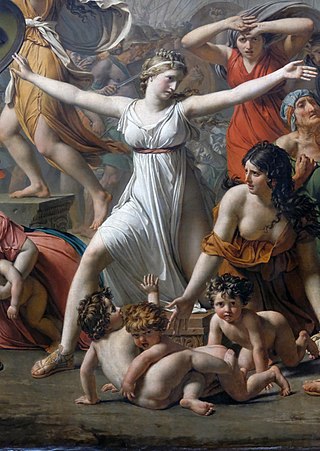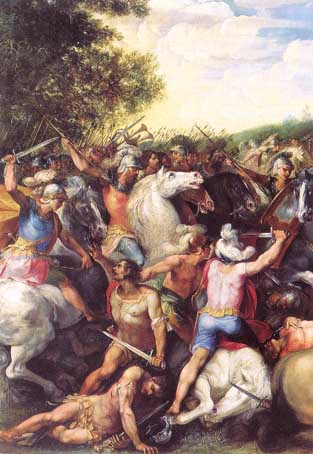Hostus Hostilius was a Roman warrior in the time of Romulus, and the grandfather of Tullus Hostilius, the third Roman king.
Hostus Hostilius was a Roman warrior in the time of Romulus, and the grandfather of Tullus Hostilius, the third Roman king.
In reprisal for the Rape of the Sabine Women, the Romans were attacked by forces sent by several Sabine towns. [1] [2] The Romans, who had anticipated rash action of this sort, quickly routed the armies of Caenina, Antemnae, and Crustumerium. [3] [4] [5] But Titus Tatius, king of the Sabine city of Cures, was more cautious, and gained access to the Roman citadel through subterfuge, forcing the Romans to fight from a disadvantageous position. [6] [7] [8] [9]
The two armies advanced toward each other along the ground between the Palatine and Capitoline hills, with the Sabine champion, Mettius Curtius, in the lead. [10] [11] Hostus Hostilius, his Roman counterpart, met him in single combat. [10] [12] Although Hostus fought valiantly, Mettius had the advantage of the ground, and slew the Roman champion. [i] Disheartened, the Roman line broke and fled to their fortifications on the Palatine, as Mettius and the Sabines gave chase. [10] [14]
Unable to control his army, Romulus vowed a temple to Jupiter Stator if his men would recover their courage, and face the enemy. As if in answer to his prayer, the Romans turned before the gates of the Palatine, so suddenly that Mettius' horse took fright and bolted, [ii] becoming stuck in the swampy ground that would become the Roman Forum. [13] The Sabine charge came to a halt, uncertain of how to proceed, and concerned for the fate of their leader, who with the encouragement of his men, managed to free his horse [iii] and escape. [10] [14] With the battle at a standstill and the outcome in doubt, the Sabine women themselves interceded, urging their husbands and fathers not to kill one another. Romulus and Tatius agreed to a truce, and joint rulership of Rome. [15] [16] [8] [17]
According to Dionysius of Halicarnassus, Hostus' wife was Hersilia, [12] who had led the Sabine women between the battle lines to end the war, [16] [3] [8] although in the more familiar account, which Livy relates, Hersilia was the wife of Romulus. [3] Plutarch reports both versions, noting a disagreement amongst his authorities. [18] At his death, Hostus left a young son, who in turn was the father of Tullus Hostilius, the third King of Rome. [19] [12] [13] Hostilius was buried in the Roman Forum, where a monument was set up and inscribed in honour of his bravery. [12]

In Roman mythology, Romulus and Remus are twin brothers whose story tells of the events that led to the founding of the city of Rome and the Roman Kingdom by Romulus, following his fratricide of Remus. The image of a she-wolf suckling the twins in their infancy has been a symbol of the city of Rome and the ancient Romans since at least the 3rd century BC. Although the tale takes place before the founding of Rome around 750 BC, the earliest known written account of the myth is from the late 3rd century BC. Possible historical bases for the story, and interpretations of its local variants, are subjects of ongoing debate.

In Roman mythology, Hersilia was a figure in the foundation myth of Rome. She is credited with ending the war between Rome and the Sabines.

The Sabines were an Italic people who lived in the central Apennine Mountains of the ancient Italian Peninsula, also inhabiting Latium north of the Anio before the founding of Rome.

Dionysius of Halicarnassus was a Greek historian and teacher of rhetoric, who flourished during the reign of Emperor Augustus. His literary style was atticistic – imitating Classical Attic Greek in its prime.

Tullus Hostilius was the legendary third king of Rome. He succeeded Numa Pompilius and was succeeded by Ancus Marcius. Unlike his predecessor, Tullus was known as a warlike king who, according to the Roman historian Livy, believed the more peaceful nature of his predecessor had weakened Rome. It has been attested that he sought out war and was even more warlike than the first king of Rome, Romulus. Accounts of the death of Tullus Hostilius vary. In the mythological version of events Livy describes, he had angered Jupiter who then killed him with a bolt of lightning. Non-mythological sources on the other hand describe that he died of plague after a rule of 32 years.

According to the Roman foundation myth, Titus Tatius, also called Tatius Sabinus, was king of the Sabines from Cures and joint-ruler of the Kingdom of Rome for several years.

In Roman legend, Tarpeia, daughter of the Roman commander Spurius Tarpeius, was a Vestal Virgin who betrayed the city of Rome to the Sabines at the time of their women's abduction for what she thought would be a reward of jewelry. She was instead crushed to death by Sabine shields and her body cast from the southern cliff of Rome's Capitoline Hill, thereafter called after her the Tarpeian Rock.
Titus Larcius was a Roman general and statesman during the early Republic, who served twice as consul and became the first Roman dictator.

The rape of the Sabine women, also known as the abduction of the Sabine women or the kidnapping of the Sabine women, was an incident in the legendary history of Rome in which the men of Rome committed a mass abduction of young women from the other cities in the region. It has been a frequent subject of painters and sculptors, particularly since the Renaissance.

The kings of Alba Longa, or Alban kings, were a series of legendary kings of Latium, who ruled from the ancient city of Alba Longa. In the mythic tradition of ancient Rome, they fill the 400-year gap between the settlement of Aeneas in Italy and the founding of the city of Rome by Romulus. It was this line of descent to which the Julii claimed kinship. The traditional line of the Alban kings ends with Numitor, the grandfather of Romulus and Remus. One later king, Gaius Cluilius, is mentioned by Roman historians, although his relation to the original line, if any, is unknown; and after his death, a few generations after the time of Romulus, the city was destroyed by Tullus Hostilius, the third King of Rome, and its population transferred to Alba's daughter city.

Romulus was the legendary founder and first king of Rome. Various traditions attribute the establishment of many of Rome's oldest legal, political, religious, and social institutions to Romulus and his contemporaries. Although many of these traditions incorporate elements of folklore, and it is not clear to what extent a historical figure underlies the mythical Romulus, the events and institutions ascribed to him were central to the myths surrounding Rome's origins and cultural traditions.

Alba Longa was an ancient Latin city in Central Italy in the vicinity of Lake Albano in the Alban Hills. The ancient Romans believed it to be the founder and head of the Latin League, before it was destroyed by the Roman Kingdom around the middle of the 7th century BC and its inhabitants were forced to settle in Rome. In legend, Romulus and Remus, founders of Rome, had come from the royal dynasty of Alba Longa, which in Virgil's Aeneid had been the bloodline of Aeneas, a son of Venus.

The gens Cloelia, originally Cluilia, and occasionally written Clouilia or Cloulia, was a patrician family at ancient Rome. The gens was prominent throughout the period of the Republic. The first of the Cloelii to hold the consulship was Quintus Cloelius Siculus, in 498 BC.
Mettius is a Latin praenomen, or personal name, which was used in pre-Roman times and perhaps during the early centuries of the Roman Republic, but which was obsolete by the 1st century BC. The feminine form is Mettia. The patronymic gens Mettia was derived from this praenomen. The name was rare in historical times, and not regularly abbreviated.

The gens Hostilia was an ancient family at Rome, which traced its origin to the time of Romulus. The most famous member of the gens was Tullus Hostilius, the third King of Rome; however, all of the Hostilii known from the time of the Republic were plebeians. Several of the Hostilii were distinguished during the Punic Wars. The first of the family to obtain the consulship was Aulus Hostilius Mancinus in 170 BC.

The gens Lucretia was a prominent family of the Roman Republic. Originally patrician, the gens later included a number of plebeian families. The Lucretii were one of the most ancient gentes, and the second wife of Numa Pompilius, the second King of Rome, was named Lucretia. The first of the Lucretii to obtain the consulship was Spurius Lucretius Tricipitinus in 509 BC, the first year of the Republic.

The gens Curtia was an ancient but minor noble family at Rome, with both patrician and plebeian branches. The only member of the gens invested with the consulship under the Republic was Gaius Curtius Philo, in 445 BC. A few Curtii held lesser magistracies during the Republic, and there were two consuls suffectus in imperial times. However, the gens is best remembered from a series of legends dating from the traditional founding of the city to the early Republic.

In Roman mythology, the Battle of the Lacus Curtius was the final battle in the war between the Roman Kingdom and the Sabines following Rome's mass abduction of Sabine women to take as brides. It took place during the reign of Romulus, near the Lacus Curtius, future site of the Roman Forum.
The gens Silvia was a minor plebeian family at ancient Rome. According to legend, the Silvii were the royal dynasty of Alba Longa, Rome's mother city, and presumably came to Rome when that city was destroyed by Tullus Hostilius in the seventh century BC. Notwithstanding their connection with Rome's foundation myths, the Silvii were plebeians, and hardly any members of this gens played a significant role in history. However, from inscriptions, several Silvii appear to have had distinguished military careers, and Silvius Silvanus was governor of Moesia Inferior in the time of Diocletian.
The gens Tatia was a minor plebeian family at ancient Rome. This gens is perhaps best known from the legendary figure of Titus Tatius, a Sabine king who fought against Romulus, and who subsequently became joint ruler of Rome. None of the Tatii held any of the higher magistracies of the Roman Republic, but a number are known from inscriptions.